TL;DR
Bridge Pages send visitors from your main article to a helpful, product-focused page on your site before they go to the merchant. Done right, they:
- increase pageviews and engagement
- open up long-tail SEO opportunities
- enable smarter monetization (multiple merchants, price history, coupons)
- reduce “thin affiliate” signals on your primary articles
With Content Egg, you can create Bridge Pages at scale using presets and AI-generated content, decide whether each click goes direct to merchant or to a Bridge Page, and even set canonical Bridge Pages as the default destination for a product across your site.
The Bridge Funnel (at a glance)
Main article / resource → Bridge Page (product details on your site) → Merchant (e.g., Amazon)
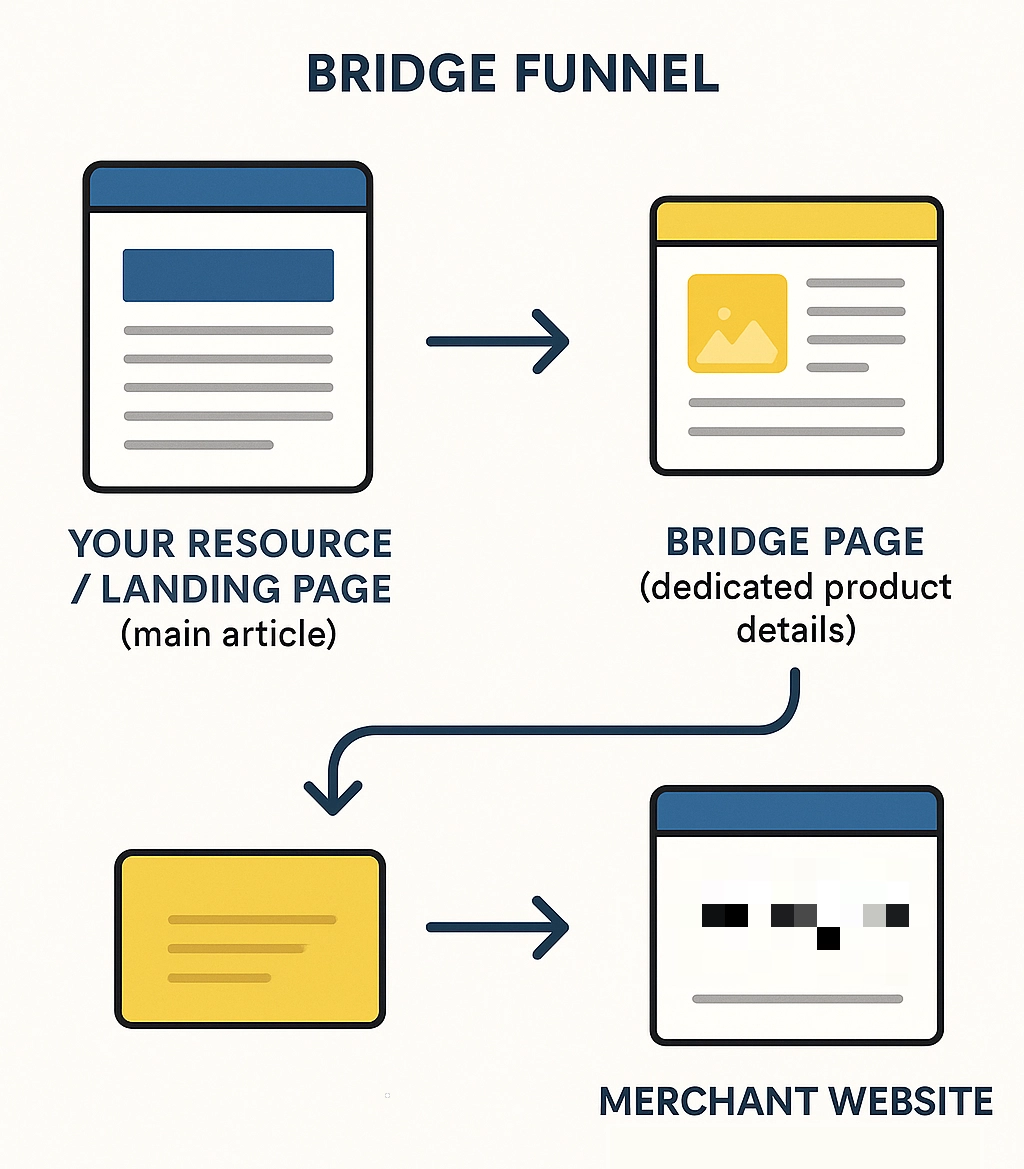
What Are Bridge Pages?Plus Alternative Names
Bridge Pages are focused product pages on your own domain that visitors land on before reaching the merchant. Think of them as a helpful middle step: they answer key questions, show prices and merchants, and build trust—so the final click is more confident.
Also called: middle pages, intermediate pages, product details pages, review pages, comparison pages, pre-sell pages (in a non-spammy, value-add sense).
Quick example:
Your roundup “Best 3D Printers Under $400” lists several models. Instead of sending every click straight to Amazon, many buttons lead to individual product pages on your site with specs, pros/cons, and best prices. From there, visitors click out to buy.
Not the goal
- Not a thin doorway or duplicate of the merchant page.
- Not a hard sell—value first, then send.
Bridge Pages vs. Landing PagesPurpose, intent, SEO targets, and conversion flow—how each page type fits in your funnel.
| Aspect | Landing Page (Resource) | Bridge Page (Product Details) |
|---|---|---|
| Purpose | Attracts and qualifies searchers; covers a topic or category | Informs and “warms up” the user about a specific product |
| Content Scope | Broad: comparisons, top picks, buying advice | Narrow: specs, pros/cons, price history, merchants, FAQs |
| Primary CTA | Explore options / pick a product | Click to merchant (after consuming helpful info) |
| SEO Focus | Head/intent keywords (e.g., “best 3D printers under \$400”) | Long-tail queries (e.g., “Creality Ender X vs Y,” “{model} specs”) |
| Outbound Links | Many affiliate links (risk of looking thin if overdone) | Concentrated on a dedicated page; cleaner main article |
Why Bridge Pages WorkThe Business Case
- More pageviews & deeper sessions. Visitors first land on your own product page.
- Smarter monetization. Show multiple merchants, surface coupons, display price history, and suggest alternatives.
- Healthier SEO signals. Fewer outbound affiliate links in the main article reduces the “thin affiliate” vibe.
- More things to rank for. Bridge Pages can target product-level long-tail queries: specs, feature questions, “vs” comparisons, FAQs.
- Stronger internal linking. Use canonical Bridge Pages as authoritative hubs for products referenced site-wide.
Shortcut: Main articles attract broad intent; bridge pages capture specific intent and monetize it—without compromising the editorial page.
Potential Consand How to Mitigate Them
- Extra click for “I want to buy now” users.
Fix: Keep top product blocks linked directly to merchant; send secondary picks to Bridge Pages. - Template-only pages risk low value.
Fix: Use AI prompts to add unique content: who it’s for, pros/cons, FAQs based on real user intent, alternatives. - Maintenance overhead.
Fix: Lean on Content Egg’s dynamic modules for merchant updates, price history, and availability. - Index bloat from mass generation.
Fix: Prioritize evergreen or high-value products; set canonical destinations; noindex thin/test pages.
How Bridge Pages Work in Content EggStep-by-Step Guide
Good news: Content Egg supports this workflow.
5.1 One-Click Imports from the Post Editor
- Open your post in wp-admin, scroll to the Content Egg metabox.
- Add/search products as you normally would.
- Click “Import as Bridge Page” and pick a Preset (e.g., price comparison, WooCommerce listing, product review, or your custom preset).
- Choose specific products, or import for all module products.
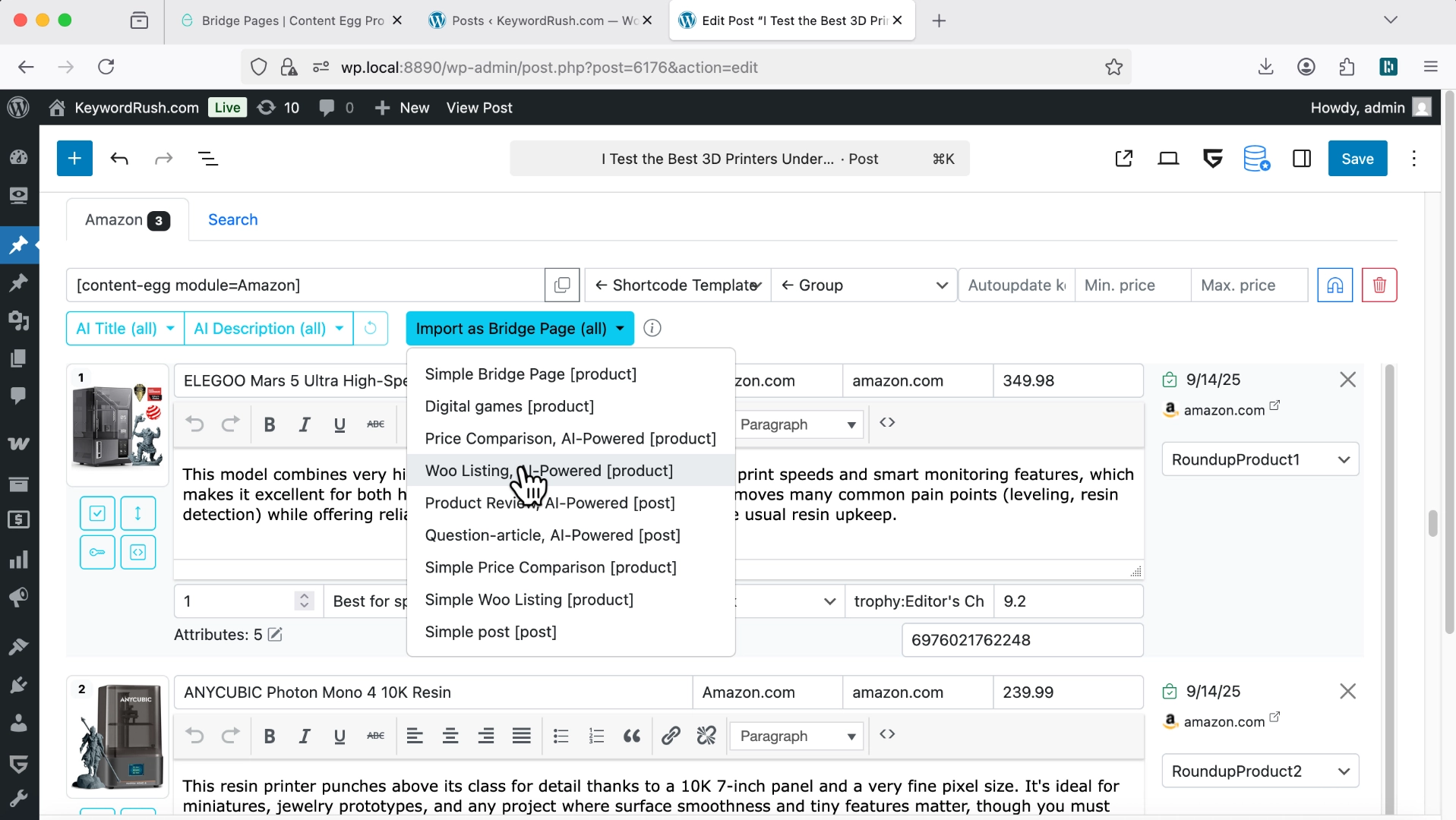
You’ll see a small toast showing how many items were queued.
5.2 Bridge Pages Are Queued (Not Instant)
- Go to Content Egg → Import Tools → Queue to track progress.
- Refresh your post editor later: products with Bridge Pages will show a small link icon + quick edit link.
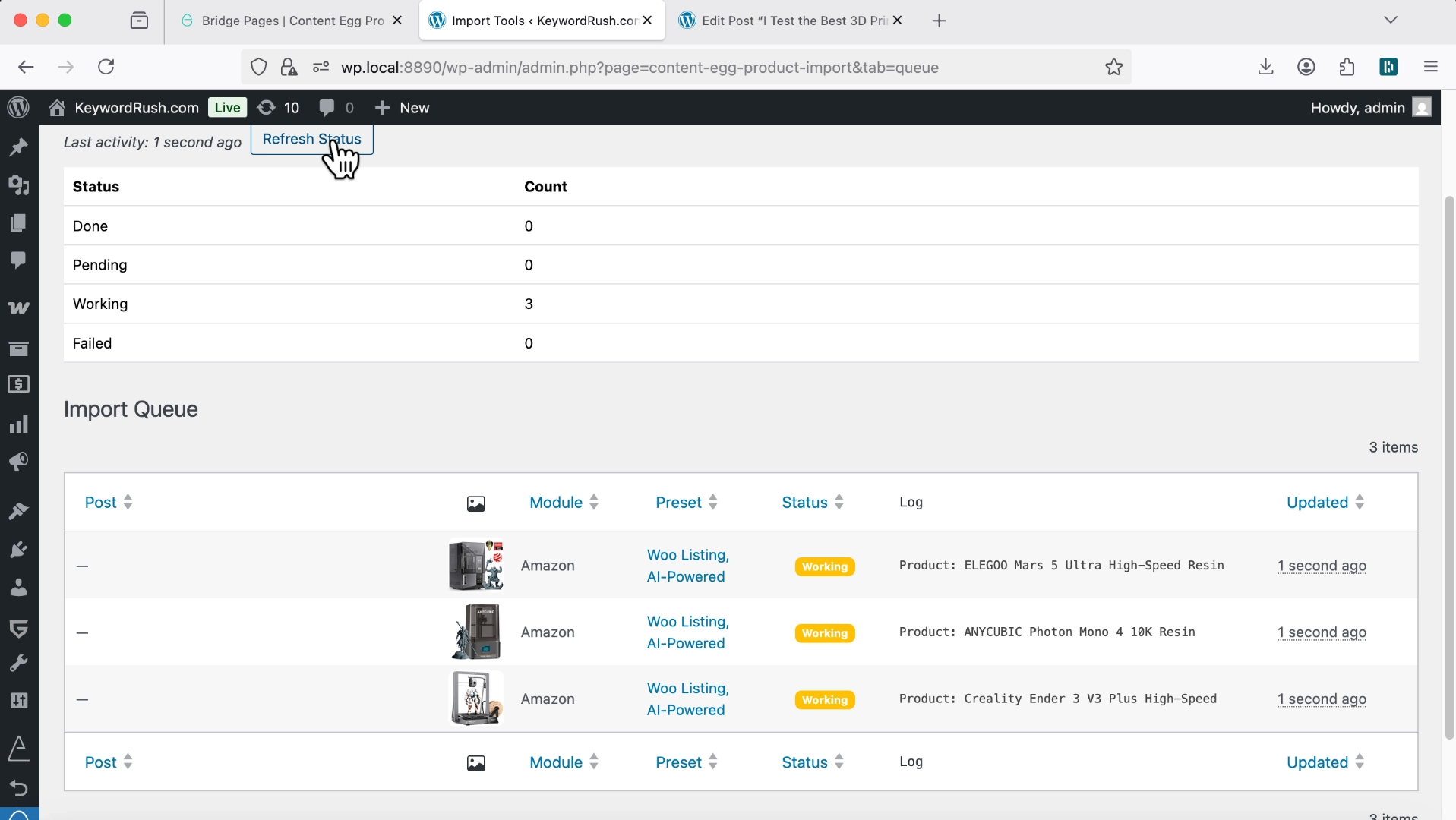
5.3 Presets = Scale With Control
A Import Preset defines how imports are created:
- Post type: Post or WooCommerce Product
- AI prompts: generate structured, helpful content (see §6)
- Shortcodes and blocks: add price comparison, history, coupons
- Taxonomies/templates: map categories, add templates or custom fields
- Canonical Bridge Pages (toggle): make imported Bridge Pages the site-wide default destination for that product
Canonical ON: any mention of that product across your site links to this Bridge Page (unless you override per post).
Canonical OFF: mapping applies only in the post where you created it.
5.4 Where Should Buttons Send Users?
Control the click path in three places. Local settings override the global default.
Global default
Content Egg → Settings → Frontend → Link destination preference
- Prefer Merchant (affiliate): send clicks straight to the retailer.
- Prefer Bridge Page (on your site): send clicks to your bridge page when one exists.
Per-block override (Gutenberg)
In the block sidebar → Display Options → Link Destination
- Auto: follow the global setting
- Prefer Merchant
- Prefer Bridge Page
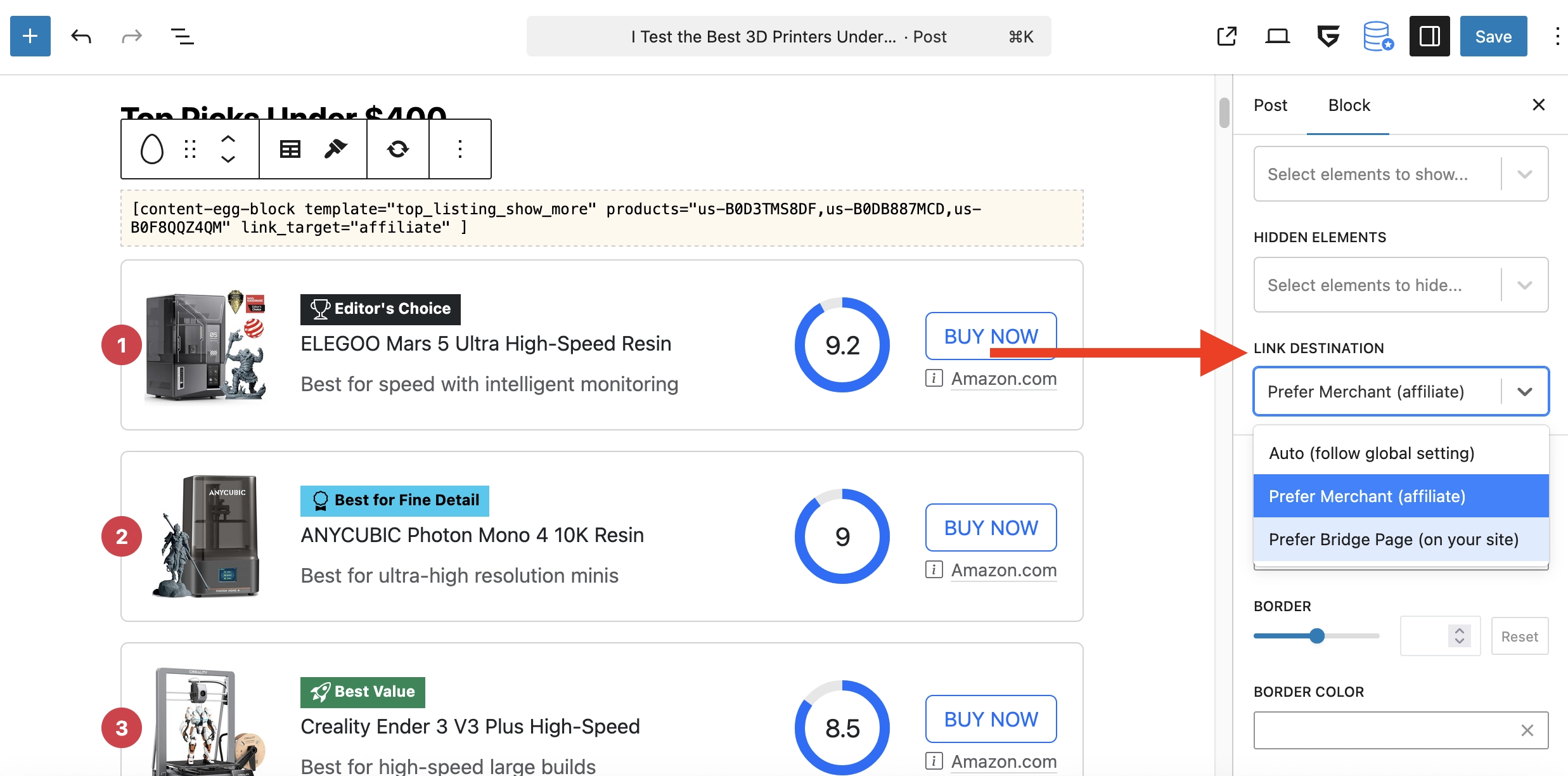
Per-shortcode override (Classic editor)
Add link_target= to your shortcode: affiliate | bridge | auto
Examples
[content-egg-block template="top_listing" link_target="affiliate"]
[content-egg-block template="review_box" link_target="bridge"]Workflow tip
Use a hybrid: set the global to Prefer Bridge Page for most products, then override the top pick block in a roundup to Prefer Merchant for shoppers who want a fast purchase.
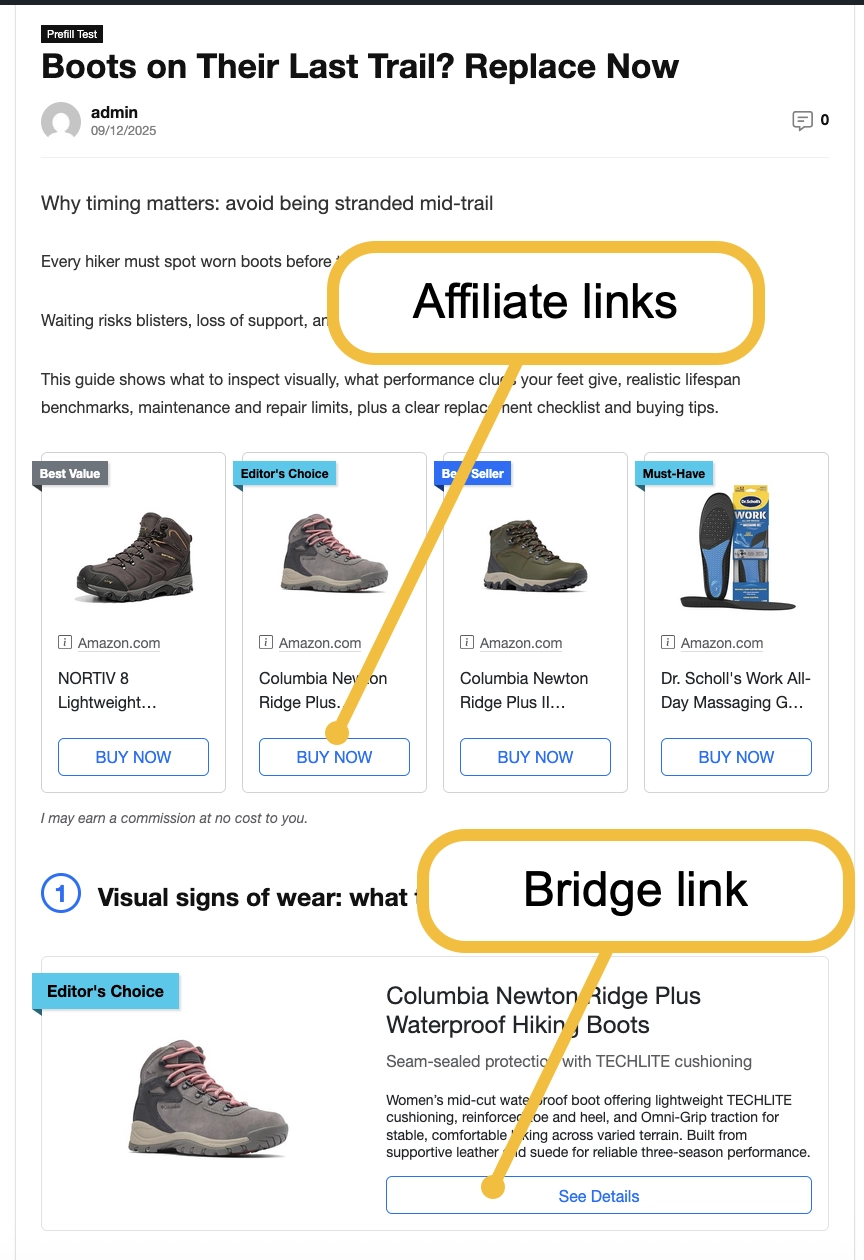
5.5 Button Text (Optional)
Small wording changes can lift CTR and clarify intent.
Where to set it
Content Egg → Settings → Frontend
- Product Button Text (affiliate): used when linking to merchants
- Bridge Button Text: used when sending to your bridge page
Dynamic tags
Both fields support %MERCHANT%, %DOMAIN%, %PRICE%, %STOCK_STATUS%.
Proven phrasing
- Affiliate buttons: “Buy now”, “Buy at %MERCHANT%”, “Check price on %DOMAIN%”, “From %PRICE%”
- Bridge buttons: “See details”, “View product page”, “Read review”, “Compare prices”
Quick test idea
Try intent-paired copy:
- Roundup top pick → “Buy at %MERCHANT%” (merchant link)
- Secondary picks → “See details” (bridge page)
Make the AI Do the Heavy LiftingWithout Losing Quality
Use your preset’s AI prompt to generate useful, unique content. A proven structure looks like this:
Prompt idea (customizable in your preset):
- Intro (2–3 lines): Summarize who the product is for
- Key features & specs: Present as bullet points
- Pros & cons: Keep it balanced and concise
- Who should buy / who should skip: Add clear guidance
- Alternatives: Suggest similar products
- FAQ (3–5 items): Answer questions based on real-world search intent
After that, embed Content Egg shortcodes or blocks for price comparison, price history, and related merchants.
💡 Pro tip: Alternatives can be auto-fetched using a Content Egg shortcode with the keyword parameter.
What it looks like on the page:
- Human-readable intro
- Clear specs table
- Pros/cons that don’t sound like a brochure
- Price box showing best current offer
- A small chart: price history (great for deal hunters)
- “Also consider” with two similar models
Avoid copy-paste from the merchant. A bit of editorial polish + specific use-case advice makes a huge difference.
What Content Works Best on Bridge Pages?Key elements that build trust, answer questions, and drive clicks
- Essentials: Core specs, key features, and real photos (if you have them)
- Context: Explain who the product is for — and who it isn’t
- Decision helpers: Pros and cons, comparisons with alternatives, compatibility notes
- Price intelligence: Current price, history charts, coupons, stock updates, multiple merchant options
- Trust factors: Clear affiliate disclosure (site-wide or on-page), accurate data, editorial notes for transparency
- FAQ: Cover common objections and People-Also-Ask style questions from search
Compliance With Search Engine GuidelinesBest Practices to Keep Google Happy
Are Bridge Pages “thin” content?
Short answer: They’re fine when they’re helpful. They become risky only if they behave like doorway pages (near-duplicate pages that exist only to funnel users).
Keep it safe and valuable:
- Provide unique, useful information (not just merchant copy)
- Demonstrate E-E-A-T: experience (hands-on notes), expertise (clear explanations), trust (disclosures, accurate pricing)
- Avoid spinning up thousands of low-value, duplicated pages
- Use clean templates, fast performance, and logical internal linking
- Apply indexing rules wisely (noindex thin or temporary pages)
On-Page SEO & Schema EnhancementsStructured Data Tips for Better Rankings and Rich Snippets
Adding the right schema helps search engines understand your bridge pages and reward them with rich snippets in the results.
- Product schema: Highlights product name, price, availability, and ratings in search.
- Review schema: If you include editorial ratings, wrap them in review markup.
- FAQ schema: Perfect for Q&A sections that answer common objections or “People Also Ask” queries.
How to enable it:
- If you use WooCommerce for bridge pages, WooCommerce automatically generates JSON-LD product schema.
- Content Egg can also insert product schema directly into posts. Go to Content Egg → Settings → Frontend and enable Add Schema Markup.
Internal linking ideas:
- Flow visitors naturally: Roundup → Canonical Bridge Page → Related Accessories
- Link the “Alternatives” section to other bridge pages.
- Use category hubs to point to your most important product pages.
Performance best practices:
- Compress and properly size images.
- Lazy-load videos and media where possible.
- Avoid unnecessary heavy scripts.
- Keep price/offer modules lightweight so pages load quickly.
TroubleshootingCommon Pitfalls
- “Bridge Page created but my button still goes direct.”
Check the link destination hierarchy: Block or shortcode overrides can supersede the global setting. Confirm canonical mapping if relevant. - “Nothing happened after I clicked Import.”
Bridge Pages are queued, not instant. Check Content Egg → Import Tools → Queue. - “Pages aren’t engaging.”
Enrich with real-world context: who it’s for, pros/cons, alternatives, price history, and FAQs. - “I generated too many pages.”
Focus on evergreen or high-value products, set canonical for popular items, and noindex thin or temporary pages.
FAQsQuick Answers to Common Questions
Do Bridge Pages work with WooCommerce?
Yes. In your Preset, set the post type to WooCommerce Product to import as products in your catalog.
Can I change where a product points later?
Yes. Importing a new Bridge Page for the same product replaces the previous mapping.
What happens if I delete a Bridge Page?
Content Egg cleans up references so other posts won’t link to a deleted page.
Are Bridge Pages considered thin content?
Not when they’re helpful and unique. Avoid doorway-like duplicates. Add real value: specs, pros/cons, FAQs, alternatives, and fresh pricing.
Should my top picks go direct or to Bridge Pages?
Often a hybrid wins: top pick → direct to merchant for speed buyers; other picks → Bridge Pages for researchers.
How do I customize the “See details” button?
Content Egg → Settings → Frontend → Bridge Button Text. Dynamic tags supported: %MERCHANT%, %DOMAIN%, %PRICE%, %STOCK_STATUS%.
Can I import many Bridge Pages at once?
Yes. From the post editor, choose Import as Bridge Page and select products or import for all module products. Creation runs via the Queue.
What are canonical Bridge Pages?
A canonical Bridge Page becomes the site-wide default destination for that product (unless you override per post).
Conclusionand Next Steps
Bridge Pages give you more control over the user journey, more engagement, and healthier SEO. With Content Egg + AI, you can build them quickly, keep them useful, and scale them across your site with presets and canonical mapping.
Try this:
- Set your global preference to Prefer Bridge Page.
- Override only your top pick blocks to Prefer Merchant.
- Build a Preset that generates useful AI content plus price modules.
- Mark evergreen products as canonical, then measure results.
Keep learning:
- How to design AI prompts that produce helpful, on-brand product pages
- Building comparison tables and “vs” sections that users love
- Advanced internal linking with canonical Bridge Page hubs
Appendix: Handy Snippets
AI Bridge Page Writer — Prompt (paste into your Content Egg Preset)
You are writing a bridge page (pre-sell product page) for an affiliate site.
Audience: shoppers comparing options and ready to decide.
Tone: friendly expert, plain language, honest about trade-offs.
Style: short sentences, active voice, skimmable headings, tight bullets.
Product data in JSON:
%PRODUCT%
Hard rules
- No hallucinations. Use only facts or widely accepted generalities (e.g., what a spec means), clearly marked.
- Never invent prices, discounts, coupons, stock, or guarantees.
- Don’t copy manufacturer text verbatim—paraphrase.
- No medical/health claims, legal/financial guarantees, or unverifiable superlatives.
- Speak to the reader as “you.” Avoid jargon; define terms if used.
- No outbound links; buttons/disclosures are handled by the theme/plugin.
- If a section cannot be supported from the product, omit that section.
Length targets (flexible): 1200–1500 words total. Bullets ≤ 14 words each. FAQs: 1–3 sentences each.
Output format (Markdown, no emojis):
# {Product name} — {benefit-led headline, 7–12 words}
A one-sentence hook that says what it does and for whom.
## Who it’s for
2–3 short lines summarizing the ideal buyer and main use cases.
Optionally add who it’s not for in one line.
## Key features & specs
Bulleted list of 5–8 highlights. Pair each feature with a benefit.
- {Feature/spec} — why it matters to you
- …
## Pros & cons
Balanced bullets (3–5 each). Be candid.
Pros
- …
Cons
- …
## Should you buy it?
2–4 lines with clear guidance. State the strongest reason to choose it and one case to skip.
## Alternatives
If the product includes related/alternative items, list 2–3 with one-line reasons when each is better.
- {Alternative name} — better for {reason}
- {Alternative name} — better for {reason}
## FAQ
Answer common “People also ask”-style questions present or inferable from the product. If unknown, say how to check.
Is it compatible with … ?
Answer.
How loud / how long does the battery last?
Answer.
What’s in the box / warranty?
Answer.
Can I use it for … ?
Answer.
## Editor’s notes
1–2 lines for transparency (e.g., “Summary based on specs, vendor data, and hands-on reports.”). Remind readers to check current price/availability on the next page.
SEO guidance (embed naturally):
- Use the product’s exact name once in the H1 and early in the intro.
- Naturally weave primary terms (brand, model, category, key features).
- Prefer concrete nouns/verbs over adjectives. Avoid keyword stuffing.
Performance & compliance cues (for writing only):
- Keep sentences short; front-load value in each paragraph.
- Avoid vague urgency or “guaranteed results” language.
- Do not mention affiliate links; the template adds disclosures/buttons.

With 20 years in affiliate marketing, Serge creates practical WordPress tools such as Content Egg and External Importer that help publishers manage and grow their affiliate sites.

